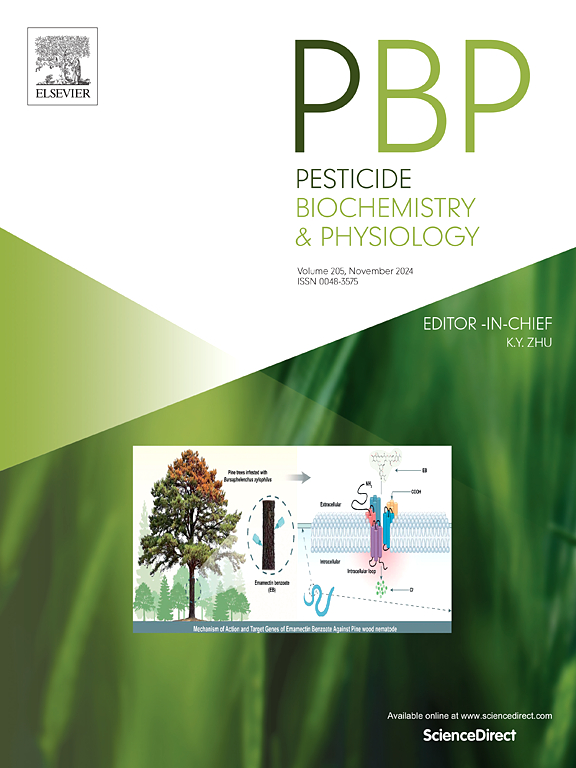Silencing OdfoP-gp1 and OdfoP-gp3 with dsRNA increased the lethality of the nonsteroidal ecdysone agonist RH-5849 against Odontotermes formosanus (Shiraki)
IF 4.2
1区 农林科学
Q2 BIOCHEMISTRY & MOLECULAR BIOLOGY
引用次数: 0
Abstract
Odontotermes formosanus (Shiraki) is a highly damaging social insect that causes significant economic losses. Insect growth regulators (IGRs) are efficient and environmentally friendly insecticides. 1,2-dibenzoyl-1-tert-butylhydrazine (RH-5849), a nonsteroidal ecdysone agonist of IGR, is highly effective in controlling various insect species. In this study, the toxicity of RH-5849 against O. formosanus was assessed. To investigate whether ATP-binding cassette (ABC) transporter proteins, detoxification enzymes, play crucial roles in the defense of O. formosanus against RH-5849, transcriptome sequencing was conducted in O. formosanus. Through RNA sequencing, 27 ABC transporter protein genes were identified, 23 of which were significantly upregulated after O. formosanus was exposed to RH-5849, especially two P-glycoprotein genes, OdfoP-gp1 and OdfoP-gp3, whose expression levels were the most significantly upregulated, at 5.79 and 5.56, respectively. Furthermore, using dsRNAs to interfere with the expression of OdfoP-gp1 and OdfoP-gp3, we found that the maximum interference efficiency was achieved at 24 h, with efficiencies of 85.30 % and 59.59 %, respectively. Based on these findings, dsRNA was coupled with RH-5849, and the results indicated that the lethality of RH-5849 against O. formosanus significantly increased following dsRNA interference. Overall, the lethality of RH-5849 significantly increased following dsRNA interference, suggesting that ABC transporter proteins, especially P-glycoproteins, play a crucial role in the defense of O. formosanus against RH-5849. This study provides a new strategy for termite control through the combination of dsRNA and IGR.

求助全文
约1分钟内获得全文
求助全文
来源期刊
CiteScore
7.00
自引率
8.50%
发文量
238
审稿时长
4.2 months
期刊介绍:
Pesticide Biochemistry and Physiology publishes original scientific articles pertaining to the mode of action of plant protection agents such as insecticides, fungicides, herbicides, and similar compounds, including nonlethal pest control agents, biosynthesis of pheromones, hormones, and plant resistance agents. Manuscripts may include a biochemical, physiological, or molecular study for an understanding of comparative toxicology or selective toxicity of both target and nontarget organisms. Particular interest will be given to studies on the molecular biology of pest control, toxicology, and pesticide resistance.
Research Areas Emphasized Include the Biochemistry and Physiology of:
• Comparative toxicity
• Mode of action
• Pathophysiology
• Plant growth regulators
• Resistance
• Other effects of pesticides on both parasites and hosts.

 求助内容:
求助内容: 应助结果提醒方式:
应助结果提醒方式:


